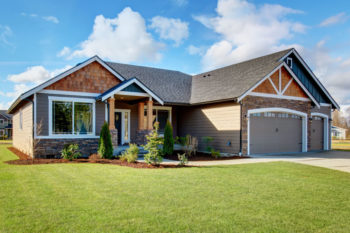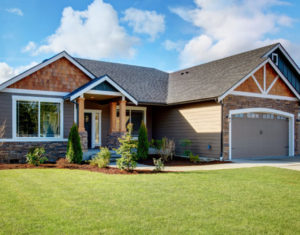Build Your Own House Meeting Your Exact Specifications
How many of us dream of the perfect home? A house designed specifically for our lifestyle complete with the latest amenities and breathtaking view. Yet, how many of us think it’s too difficult, too expensive, or just too much of a hassle? So, we settle for a house that suffices, without ever truly being completely happy with it. What if there was an affordable way you could build your own house with all the options you’ve always wanted?
Why You Should Consider Designing a Custom Home
If you have ever shopped for a home, you know how time-consuming it is to find the perfect existing house. Even after giving your real estate agent a list of attributes, you’re still shown houses that don’t meet your expectations. As your search continues, you may find yourself eliminating certain features before you settle on something you can live with. How many of us wish we had an extra bedroom, bathroom, more storage space, or just a bigger plot?
In addition, there are also all the other buyers you’re contending with when buying an existing home. Other times, the market is so hot that it’s difficult to find a house meeting your expectations. Or, you may feel pressured to make an offer fast before careful consideration. Have you ever found the perfect home only to find out someone already made an offer?
However, if you choose to build your own home, there are no other competing buyers. So, you don’t have to feel pressured to make an offer quickly or settle just to get a house. You can design a house to meet your every need and pick all the options you always wanted.
Even More Reasons to Self-Build
When you build your own house, everything is obviously new, including plumbing, electrical wiring, appliances, roofing, and siding. With a new home, you’ll have a warranty on everything, protecting you for many years. Thus, you won’t need to worry about replacing anything for quite some time. This in itself can be a huge savings factor. Generally, roofing lasts about 20 years, a house with wood siding may have to be painted about every 3 years, and HVAC systems have a lifespan of 15 years. A few years after you move into an existing home, you could be facing some expensive maintenance or replacement bills.
Older homes tend to be less energy-efficient as well. When you build a new home, you can plan and incorporate economical energy designs. Today’s building materials are more energy-efficient than even just 20 years ago. The U.S. Department of Energy estimates a 25% reduction on utility bills with an energy-efficient home. This translates into a savings of over $2,200 annually.
Location, Location, Location – Or, How to Find the Perfect Spot for Your New Home
It’s the cliché of the real estate world, location, location, location. We hear it all the time in both existing and new construction. The site of your home plays a big role in the value of your house over the years. Even if you never plan on moving, your home is an investment, probably the biggest you’ll ever make. How quickly your home appreciates is largely dependent upon where you choose to locate.
Generally, land costs are lower in rural than in urban areas. For example, in some urban areas, the land value can be 50% of the total value of the home. In more rural areas, the percentage is closer to 20%. Suitable building sites can range from raw land that needs clearing to empty lots in a suburb.
When searching for the perfect place to build your home, you need to consider more than just a pretty view. The plot should have characteristics that enable you to build a house. For example, the lot should be fairly level with good drainage. Local zoning laws should allow for a residential home. Access to utilities and roadways is important too. Other additional factors you may want to consider are school districts and proximity to shopping and employment.
Tips for Planning Your Perfect Home
The first step in planning your home is to figure out your budget. Make sure it’s as realistic as possible, since both over-budgeting and under-budgeting cause problems. Both scenarios can leave you with a home that’s less than your expectations.
Begin with deciding on the most important elements your need in a home. Think about your lifestyle and design your home around it. Do you have children? Your family size and the ages of your children may influence the bedroom layout. Or, do you like to entertain a lot? A wide foyer that leads into an open floor plan may suit you. As you look through your options, carefully consider those elements that are difficult to change in the future.
Finally, don’t skimp on siding, roofing, or windows. Choosing cheaper options on these elements will cost you more in the long run. Plus, having good quality exterior components are a great benefit when trying to sell your home. Consider the maintenance factor, too. Remember that wood siding needs scraping and painting every few years, but vinyl siding will last for decades with little maintenance.
You may find yourself under-budgeting in one area to get an option that’s very important to you. That’s okay, too. Spend the extra money on things you cannot live without, especially structural components like windows. Remember, you can always add or change finishes later on.
The Right Floor Plan Is Essential
Once you know which rooms and how many you want, you have to decide on their layout. Your building flow or how people move throughout the home promotes and ensures a comfortable lifestyle. For example, you’ll want bedrooms far from the noise and traffic of the rest of the house. Typically, the kitchen is near the back entrance close to the dining room. Moreover, windows should be plentiful to allow as much natural light as possible to enter.
Many home buyers tend to look for a home that is bigger than they actually need. This leads to areas of wasted and unused space. Often too, home buyers forget about storage space. Think about not only enough storage but the right type as well. Keeping in mind your current lifestyle will ensure efficient use of floor space while creating a comfortable living area.
Pricing and Computing Your Construction Cost
When you begin planning your new home, you need to know how much it’ll cost to construct. One way to get an estimate is to figure out the cost per square foot. Of course, the location will affect the price because labor costs vary by area.
While this gives you a figure to start your planning with, it isn’t always the most accurate. First, the square footage doesn’t take into consideration the complexity of your design. Sometimes, there are additional expenses not included, such as excavation, basement, porches, or garages. Thus, it’s always best to get a detailed estimate from a home builder.
At Clear-Cut Building, we give free no-obligation estimates for your dream home. After reviewing your plans, we’ll discuss costs, time commitments, and financing to build your own house. The materials and subcontractors you choose will determine your price. However, by eliminating the general contractor, we save you thousands of dollars. Moreover, you can pocket that savings or put it toward some of the upgrades that you thought you couldn’t have in your budget!
Construction Loans – Navigating the Paperwork
Houses are expensive items and usually require financing in the form of a mortgage. In a regular mortgage, the existing home plus the land serves as collateral. However, when you’re building a home, it doesn’t exist yet to serve as collateral. Thus, home builders must secure a different type of financing, a construction loan.
Construction loans differ from permanent mortgages in several ways. First, the term or length of a construction loan is shorter, usually about 1 year. Secondly, lenders disperse funds in installments as the house progresses. When it’s time for the next disbursement, the lender sends an inspector to the site to check on the progress. Typically, lenders charge interest only on the amounts withdrawn.
Not all lenders offer construction loans. This is because construction loans pose a higher risk than permanent mortgages. The lender requires additional paperwork like blueprints to confirm costs aren’t excessive. Furthermore, the lender will require qualified and legally licensed contractors to ensure the home conforms to your local building code.
The 2 Types of Construction Loans
Like permanent mortgages on existing homes, borrowers must undergo underwriting guidelines checking their credit. Basically, there are 2 types of construction loans. One requires only one application process and closing while the other requires two.
The first type is a basic construction loan. You receive funds to cover the cost of construction only. After you complete the home, you have to apply for a permanent mortgage to pay off the construction loan. Choosing this option gives you the freedom to shop around for the best mortgage rates. It also gives you some breathing room for cost overrides. With a construction only loan, you can increase the permanent loan amount to cover the additional expenses. However, you’ll also have to undergo two separate application processes and two closings. This can entail extra fees.
Another option is a construction to permanent loan. When you’re building the home, the loan works as a construction loan. Once you’ve completed the home, the loan converts to a permanent mortgage. The benefit of this option is you only have one application process and one closing. Thus, you reduce the number of fees.
Why Not Hire A General Contractor?
A large majority of homeowners who design their own home hire a general contractor to build it for them. The general contractor oversees all aspects of the project from hiring subcontractors to keeping the project on schedule. While this is appealing to many homeowners, it comes with considerable costs. Generally, the expense is 15% to 28% of the home’s value.
But what alternative do you have when you’re limited by your knowledge and experience in the construction business? That’s where Clear-Cut Building’s expertise can help. We’ve got the experience and knowledge and you have the desire for a dream home. Together, we can make it happen while saving you thousands of dollars to build your own house.
It’s Easier to Build Your Own House Than You Think
Owning your own home is a major milestone. You work hard for many years to save for your dream. Yet, many people settle for an existing home that doesn’t always meet their needs. They believe that designing a house to meet their specifications is too cost-prohibitive. However, it’s cheaper and easier to build your own home than you think. Especially when you employ the services of Clear-Cut Building.
We have decades of experience in delivering top-quality residential and commercial construction projects. Our team of professional builders gives you the guidance to act as your own construction manager. At our initial meeting, we’ll review your plan, budget, and material choices. After making a detailed proposal, we’ll help you with your selection of suppliers and subcontractors. From the beginning to the end of the building process, we provide help and direction – all at a huge savings to you.
So, what are you waiting for? Call us today at 336-793-6962 to start building your dream. With our help, you’ll have everything you want in a home and save money in the process.

